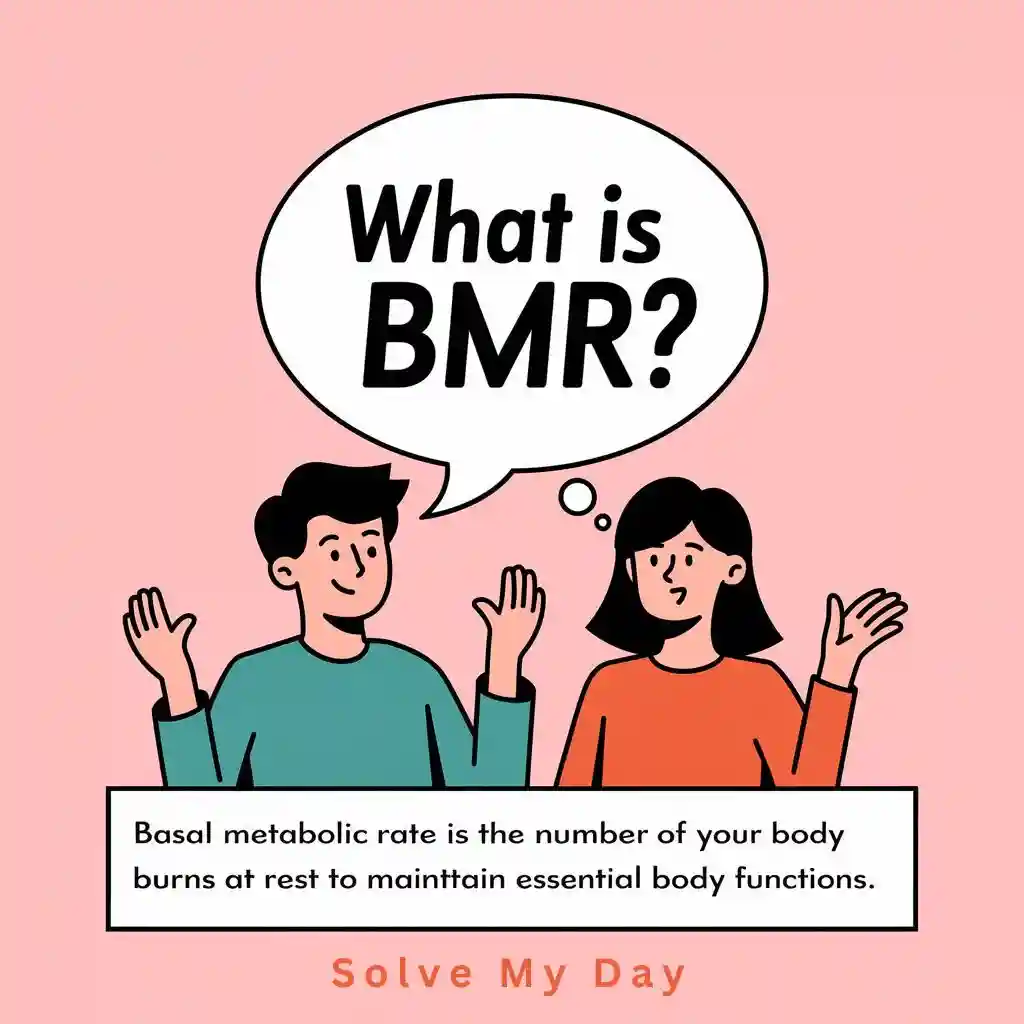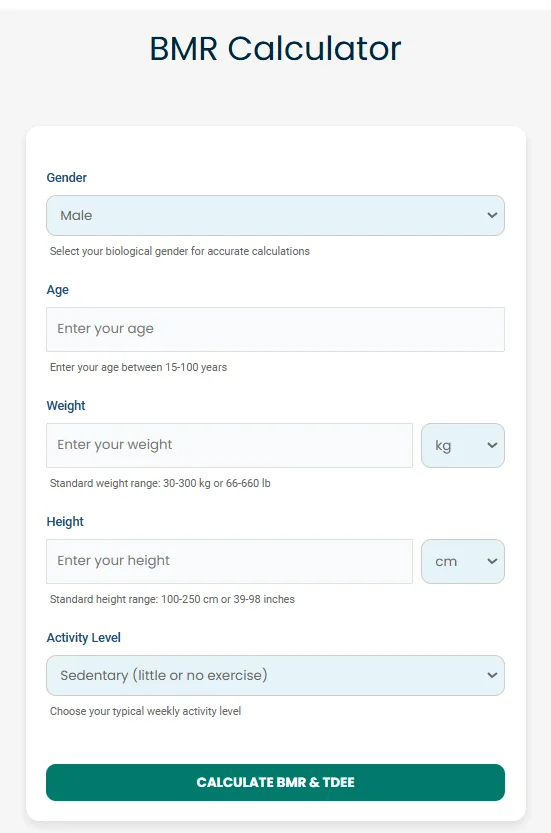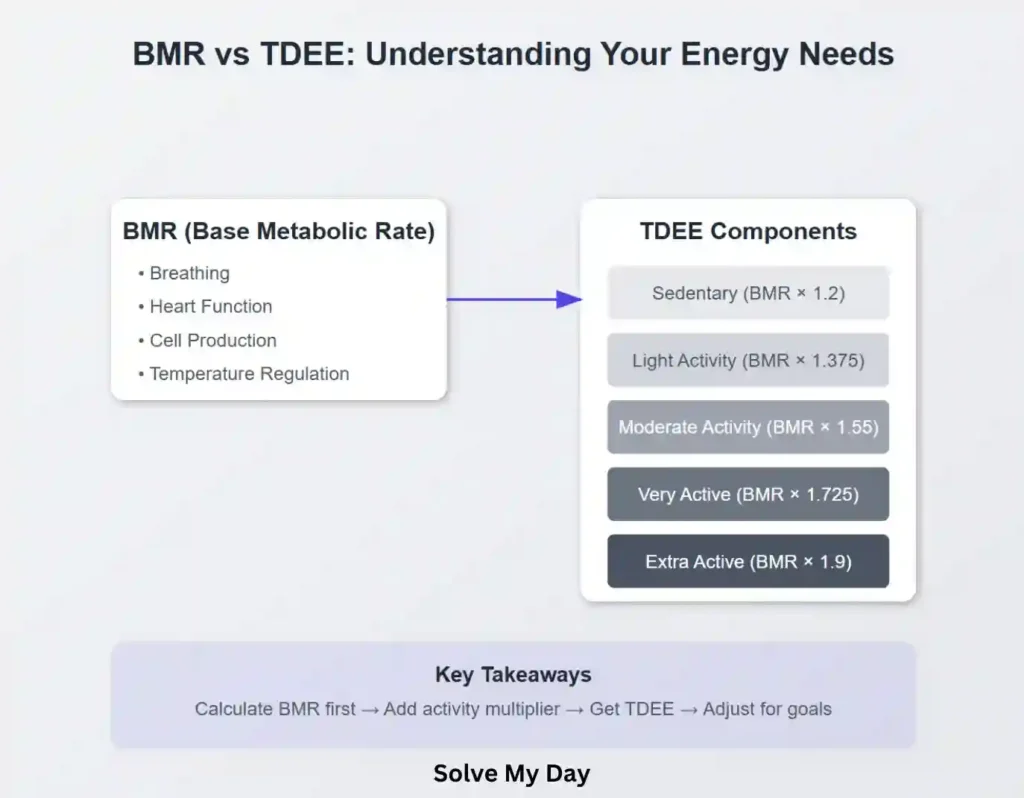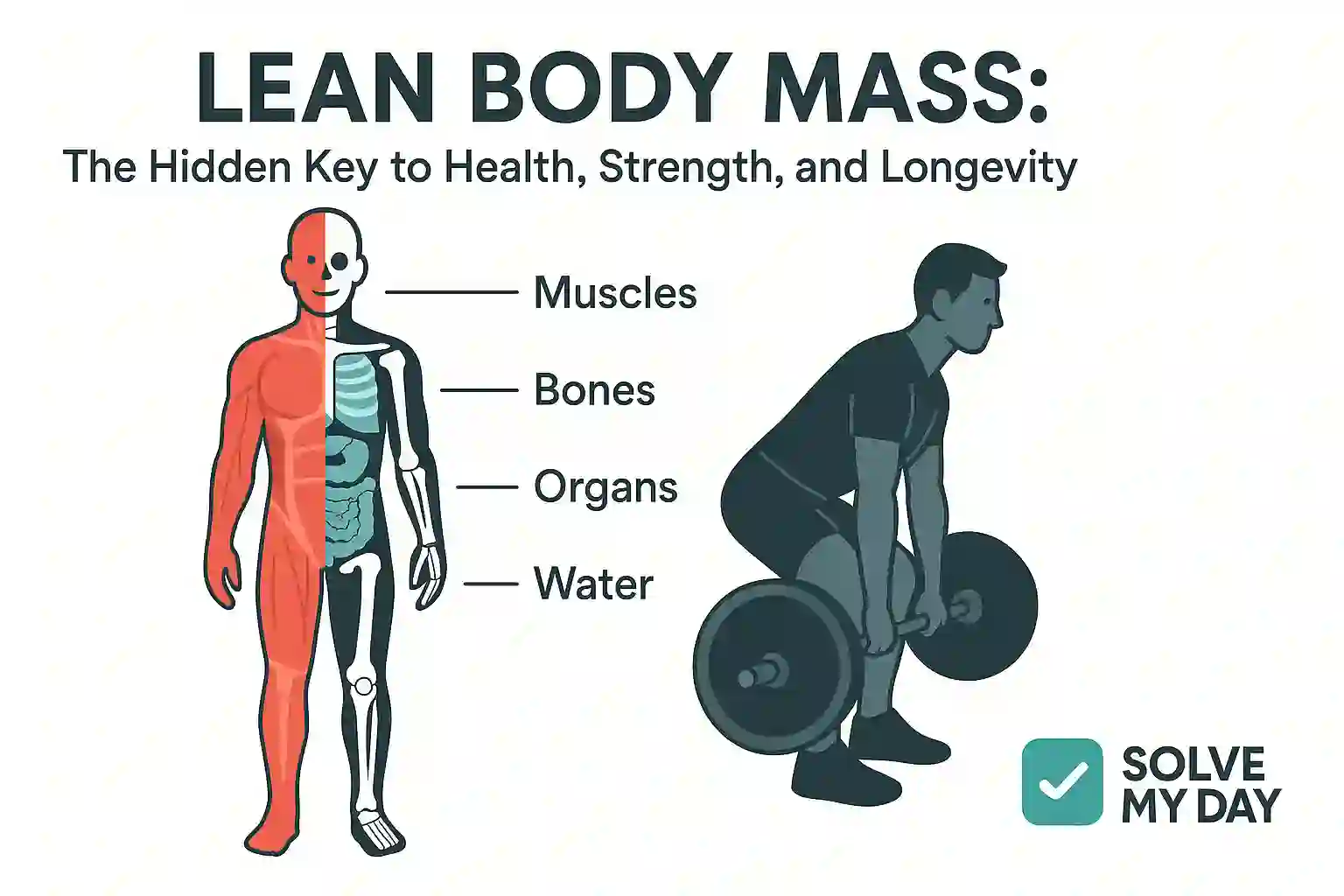Ever wonder what your body burns just to keep you breathing, even if you’re doing nothing at all? That’s your Basal Metabolic Rate, or BMR. Understanding it is like knowing the fuel gauge on your car; it tells you exactly what you need just to keep running. And without knowing this number, you’re guessing on every meal, every workout, and every goal. This BMR Calculator Guide will show you how to use this number as the foundation of your fitness journey, whether you want to drop weight, gain muscle, or maintain what you’ve achieved. So let’s dig in—no frills, just the facts on why BMR is where real progress begins.
Why BMR is the Foundation of Your Fitness Journey
Ever wondered how many calories your body burns just lying there? That’s your Basal Metabolic Rate (BMR). It’s the calories you need to keep the engine running — heart pumping, lungs breathing, brain thinking — even when you’re at rest.
Knowing your BMR isn’t just science; it’s a foundation. Whether you want to lose weight, gain muscle, or simply feel better, understanding BMR is step one. This number shows you exactly what your body needs to survive, to function.
Think of BMR like the fuel gauge in your car. If you’re running low and want to go far, you’ll need to add fuel. Add too much, and it spills over. It’s the same with calories.
For men, BMR often reads higher. Muscle burns more than fat. The stronger your muscles, the higher your BMR, the more you can eat without gaining.
Key Takeaways:
- BMR is your baseline. It tells you what you burn at rest.
- Knowing BMR lets you make a real plan, not a guess.
- Use a BMR calculator to set clear, realistic fitness goals
Simple, but it works. BMR is where every fitness journey starts.
What is BMR?

Here’s a truth most people don’t know: even if you lay still all day, your body still burns calories. This is your Basal Metabolic Rate (BMR)—the energy your body needs to keep you breathing, your heart pumping, and your temperature stable. BMR is the calories you’d burn just staying alive, no running, no lifting, just being.
The Core of Metabolism
Think of BMR as the foundation of your body’s calorie needs. It’s what you need just to exist, nothing more. BMR makes up about 60-70% of your daily calorie burn. And the higher your BMR, the more energy your body needs even at rest.
You might wonder, why does this matter? Because if you understand your BMR, you understand the very base of how your body uses energy. If you’re looking to lose weight, knowing your BMR can tell you how much to cut. Trying to gain muscle? It tells you how much to add.
Factors that Change the Numbers
Not everyone’s BMR is the same. Age, gender, and body composition are the big players here:
- Age slows it down. Each year, BMR drops a bit, especially if muscle mass declines.
- Men typically have a higher BMR than women because muscle burns more than fat, and men generally carry more.
- Muscle counts. The more you have, the higher your BMR
Key Takeaway
Understanding BMR means understanding your energy at rest. It’s the first number to know if you want to manage your weight, fuel workouts, or just eat smart. Start here, and the rest becomes easier.
How Does a BMR Calculator Work?

Want to know how many calories you burn just by being alive? That’s what your BMR (Basal Metabolic Rate) is. It’s the energy your body needs to keep going at rest. A BMR calculator does the math for you. But let’s pull back the curtain.
The Math Behind It
Most BMR calculators use the Harris-Benedict formula. It’s been around since 1919, updated over time but still solid. It’s simple enough: you plug in your age, weight, height, and gender, and out comes the number. Here’s a glimpse:
Harris–Benedict formulas revised by Roza and Shizgal in 1984.
For men, the formula is:
BMR = (13.397 × weight in kg) + (4.799 × height in cm) – (5.677 × age in years) + 88.362
For women, the formula is:
BMR = (9.247 × weight in kg) + (3.098 × height in cm) – (4.330 × age in years) + 447.593
If math’s your thing, you can run these numbers yourself. If not, the calculator does it for you in seconds.
Why These Factors Matter
Age, weight, height, and gender all play a role. Muscle burns more calories than fat, and men generally carry more muscle, so their BMR tends to run higher. As we age, metabolism slows, and BMR dips. Knowing this helps you take control of the numbers.
Real-World Use
Say you’re a 30-year-old man, weighing 70 kg, and standing 175 cm tall. Plugging into the formula, your BMR calculates to around 1,665 calories per day. That’s what your body needs to keep the lights on, no more, no less.
Key Takeaways:
- BMR measures the calories you burn at rest.
- Harris-Benedict formula calculates it using basic details: age, weight, height, and gender.
- Try it manually or let the calculator do the work.
BMR is the baseline. Understand it, and you’ll know where your energy starts.
Calculate your BMR using our BMR Calculator!
BMR Calculator for Men vs. Women
Men and women aren’t built the same. And when it comes to BMR—Basal Metabolic Rate—this difference counts.
Why Gender Matters

A man’s body, by design, carries more muscle. Muscle is like a furnace; it burns hotter than fat. Because of this, men typically have a higher BMR. Women, on the other hand, have a body composition with more fat. It’s a natural setup for energy storage, but it means the BMR is often lower.
BMR calculators know this difference. They don’t guess. They look at muscle, fat, and the work your body does just to keep you breathing, thinking, and alive. For men, this number is higher because muscle demands more calories.
How to Calculate BMR for Men
Let’s get practical. Imagine a man who weighs 180 pounds. His body runs on about 1,800 calories daily—just at rest. That’s his BMR. A woman of the same weight might need only 1,600 calories. The difference is in muscle and fat, and it’s built into the calculator.
A Straightforward Guide for Men
If you’re a man trying to calculate your BMR, use a calculator that factors in your muscle-to-fat ratio. The higher your muscle, the higher your BMR. It’s that simple. The right calculator will give you a truer number. Don’t settle for average; find a tool that speaks to your body.
Key Takeaways:
- Men naturally have a higher BMR due to muscle mass.
- Choose a calculator that accounts for your body composition.
- Remember: more muscle means more calories burned, even at rest.
BMR vs. TDEE: What’s the Difference?

What is BMR?
BMR, or Basal Metabolic Rate, is how many calories your body burns to keep you alive—no more, no less. Imagine lying still all day, no eating, no movement. Your heart pumps, lungs expand, brain fires. That’s your BMR: the bare minimum. It’s the energy cost of survival.
TDEE: The Full Picture
TDEE, or Total Daily Energy Expenditure, is BMR plus everything else. Add walking, lifting, laughing, typing, and you’ve got TDEE. It’s BMR multiplied by how active you are. TDEE counts every step, every lift. Think of it as BMR’s big brother—it’s the full picture of what your body burns in a day.
Here’s a quick way to see it:
| Metric | Definition | Purpose |
| BMR | Calories to survive at rest | For a baseline read on daily energy needs |
| TDEE | BMR + all physical activity | For a total read on daily energy needs |
When to Use Each
So, why choose one over the other? Use a BMR calculator to get your baseline—a good start if you’re after weight maintenance. But if your goal is to lose or gain weight, TDEE is what you need. TDEE tells you how much energy you burn in the real world, factoring in all activity. BMR alone? It’s half the story.
Key Takeaways:
- For basics: Start with BMR. It’s the foundation.
- For real results: Use TDEE. That’s the number to hit if you’re looking to change weight.
Remember, calories aren’t just numbers—they’re fuel. BMR is your engine idle. TDEE is the engine with you driving.
How to Use Your BMR for Weight Loss, Muscle Gain, and Maintenance
Let’s get one thing straight: if you don’t know your BMR, you’re guessing. And guessing won’t get you far with weight loss, muscle gain, or staying steady. BMR is the number of calories your body burns at rest. It’s your baseline — the fuel you need just to exist. Here’s how you use it to reach your goals.
Weight Loss: Cut Calories, But Don’t Cut Corners
To lose weight, you need to burn more calories than you consume. That’s simple math, but it’s hard work. Here’s where your BMR comes in. Find your BMR and subtract 300-500 calories. That’s enough of a deficit to lose weight without starving your body.
Say your BMR is 1,800 calories. Eating around 1,300 to 1,500 calories will put you in a safe deficit. At this pace, you’ll lose about a pound a week. Slow? Maybe. But it’s sustainable, and you’re more likely to keep the weight off.
- Key Tip: Don’t cut more than 500 calories below your BMR. Going too low messes with your metabolism, and you’ll lose muscle along with fat. You don’t want that.
Muscle Gain: Fuel the Fire
Building muscle takes more than lifting weights. You need a calorie surplus — that’s eating above your BMR. Aim to add 250-500 extra calories to your BMR. This gives your body the energy to repair and grow muscles after workouts.
If your BMR is 2,000 calories, try eating 2,300 to 2,500. Don’t rush it. Packing in calories sounds great until you’re gaining fat faster than muscle. Add calories slowly and see how your body reacts. Adjust as needed.
- Pro Move: Prioritize protein. Aiming for about 1 gram per pound of body weight helps fuel muscle growth.
Maintenance: Stay Steady, Keep It Simple
When you’re happy with your weight, eat around your BMR. If you’re burning roughly 2,000 calories a day (your BMR), consume close to that. Small adjustments keep you on track. Track your weight, tweak by a few calories if you start to drift.
- Tip for Stability: Even on maintenance, watch your intake. Small splurges add up fast.
Takeaway:
Using your BMR lets you cut through the noise. Set your calorie target based on your goal, whether it’s a deficit, surplus, or steady line. Weight loss, muscle gain, maintenance — it’s all here. Track your BMR, and you control the outcome.
Factors That Affect Your BMR
Your Basal Metabolic Rate (BMR) isn’t just a number. It’s a measure of the energy your body needs to keep you alive and breathing. This number changes based on a handful of hard facts about your body. Here’s what you need to know.
Age
With each year, BMR falls. This isn’t a theory—it’s a fact. When you’re young, your body burns more calories at rest. But as you age, muscle mass drops, and fat gains a little more ground. Muscle burns calories even when you’re sitting still; fat doesn’t. So, as you lose muscle, BMR slows down. By the time you’re 40 or 50, you’re looking at a quieter metabolism than you had at 20.
Gender
Men usually have a higher BMR than women. It’s not just muscle—it’s also size. Bigger bodies burn more energy to keep vital systems running. But the main difference comes from muscle mass. Men, thanks to testosterone, often carry more muscle. And muscle is a calorie-burner. Women, on the other hand, have more fat by nature, partly for things like childbirth. So even when a man and woman are the same size, the man’s body will usually burn a little more at rest.
Body Composition
Here’s the bottom line: muscle burns more calories than fat. Two people can weigh the same, but if one has more muscle, that person’s BMR will be higher. Picture a professional athlete who’s all lean muscle standing next to someone who doesn’t work out. The athlete’s body will burn more calories doing absolutely nothing.
Genetics and Hormones
Genetics sets the baseline for your BMR. You can’t outsmart your DNA. Some people have a high natural BMR, while others are lower. Hormones play a part, too. Thyroid hormones, in particular, control how fast or slow you burn energy. An overactive thyroid? BMR goes up. An underactive thyroid? It slows down.
Key Takeaways:
- Age: BMR drops as muscle declines with age.
- Gender: Men’s higher muscle mass means a higher BMR.
- Body Composition: More muscle equals a higher BMR.
- Genetics and Hormones: DNA and hormone levels set the pace for metabolism.
If you know these factors, you know your BMR better. Understanding your body means you can make smarter choices for your health and fitness.
How to Increase Your BMR Naturally
If you want your body to burn more calories at rest, don’t rely on shortcuts. To raise your Basal Metabolic Rate (BMR), make these simple but powerful changes.
Build Muscle
Muscle isn’t just for lifting. Every pound of muscle burns six calories a day at rest, while fat burns only two. It’s simple math. Build more muscle, and you raise your baseline calorie burn. To do this, strength train two or three times a week. Push yourself—whether that’s lifting dumbbells or using your body weight. The muscle sticks with you, working day and night.
Stay Active
Non-exercise activity thermogenesis, or NEAT, is a long name for small actions. NEAT is every step you take beyond the gym: walking to the store, standing up every hour, taking the stairs instead of the elevator. These little choices burn more calories than you’d think. Try walking five minutes every hour or stretching between meetings. Your BMR will notice.
Eat Protein, and Eat Enough of It
Your body uses more energy to process protein than it does for carbs or fat. Eating protein-rich meals boosts your metabolism slightly—about 10-15% for each meal. Eggs, lean meats, and beans work well. Aim for a serving of protein with each meal to keep your metabolism steady.
A Routine That Works
Try this:
- Strength train twice a week.
- Walk 30 minutes a day.
- Stand or stretch every hour.
- Eat a high-protein snack mid-morning or mid-afternoon.
Takeaway:
Forget the gimmicks. Boosting BMR isn’t about drastic measures; it’s about steady, simple actions. Train hard, stay active, and eat smart. The numbers will add up.
BMR and TDEE: Using Both for Better Results

BMR is the base. It’s the calories you burn just being alive, lying still, breathing. But that’s not the whole story. Total Daily Energy Expenditure (TDEE) tells you what you burn with everything else—walking, working, lifting weights, even fidgeting. Together, they give you the truth about your calorie needs.
Step 1: Calculate Your BMR
Start with a BMR calculator. It’s simple and gives you the number of calories your body needs to function. If you want to be precise, go manual. Use the Harris-Benedict equation, or whichever formula the calculator shows. Get that baseline.
Step 2: Find Your TDEE
Now, take that BMR and add the rest. TDEE accounts for everything you do. Most calculators ask for your activity level, from sedentary to highly active. Choose what fits. No need to overestimate; TDEE only works if it’s honest.
Why Use Both?
BMR alone is only half the picture. TDEE is the full canvas. Want to lose weight? Use TDEE to set your calorie deficit. Building muscle? Use TDEE for a slight surplus.
Key Takeaways:
- Calculate BMR first—it’s your foundation.
- Add activity levels to get TDEE for a complete picture.
- Use both to guide your goals—whether you’re cutting, bulking, or holding steady.
Try them. Adjust as you go. When you know your numbers, you control the outcome.
Common Questions About BMR Calculators
Is a BMR Calculator Accurate?
Can You Use BMR for Weight Loss?
What’s a Healthy BMR Range?
Key Takeaways:
- Accuracy: Calculators are close, but muscle and fat ratios matter.
- Weight Loss: Use BMR to guide a safe calorie deficit.
- Healthy Range: BMR varies with age, muscle, and more—don’t overthink it.
Get your BMR right, and you’re working with solid ground. For weight loss, for muscle gain, or just staying steady, it’s the number that tells you what your body really needs.
Conclusion
Know this: your BMR isn’t a guess. It’s a number grounded in the facts of your own body. Each calorie you need to breathe, to think, to stand is right there in that number. And once you have it, you have a tool. No more hoping. No more wondering if the diet’s too light or the workout too much. You know what your body demands just to live.
Use that number. Let it be the starting line for everything you aim to do. You want to lose weight? Set your calories below your BMR. Want to gain muscle? Set them above it. Keep track, measure progress, and let that BMR be your map. It’s the baseline, the truth beneath all the noise.
Here’s what it looks like in practice:
- For weight loss: Cut 300-500 calories below your BMR and let it work slowly, steadily.
- For muscle gain: Add 250-500 calories above it and fuel each rep, each lift.
- For maintenance: Eat right at your BMR to keep steady.
Simple, but it works. The number doesn’t lie. Stick to it, adjust as you go, and don’t waste time on fads or flashy solutions.
Key Takeaways:
- Know your BMR. This is your ground zero.
- Adjust calories based on your goals, and stick to the numbers.
- BMR is your tool for control. Use it, and you won’t need to guess again.
In the end, it’s all about what works. Your BMR isn’t just a number—it’s a guide. Follow it, and you’ll find your way to every goal you’ve set.


